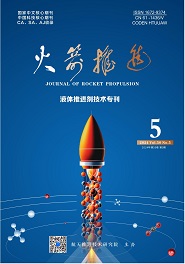航天推进技术研究院主办
XIANG Le,LI Chunle,XU Kaifu,et al.Inducer super-synchronous rotating cavitation propagation mechanism[J].Journal of Rocket Propulsion,2022,48(02):76-85.
诱导轮超同步旋转空化传播机理
- Title:
- Inducer super-synchronous rotating cavitation propagation mechanism
- 文章编号:
- 1672-9374(2022)02-0076-10
- 分类号:
- TV131.32 V431
- 文献标志码:
- A
- 摘要:
- 为了揭示超同步旋转空化的传播机理,对二维平板叶栅内部非定常空化流动进行数值模拟研究,叶栅的几何参数和模拟工况均来自真实诱导轮试验结果。结果表明:仿真预测的叶栅空化断裂点与试验结果接近,随空化数下降空化区的演变规律与试验结果一致。在一定的空化数范围出现传播频率比为1.1~1.4的旋转空化现象,对流场细节的深入分析发现空化区与来流冲角的相互作用是空化区波动沿周向超同步传播的机理。空化区与叶片前缘的冲角是呈正相关的,同时空化区增大会在尾缘诱发顺时针涡扰动,空化区减小会在尾缘诱发逆时针涡扰动,当扰动达到叶片喉部位置时,会对相邻叶片产生影响,空化区增加会导致相邻叶片冲角减小,相应空化区也减小,空化区减小会导致相邻叶片前缘冲角增大,相应空化区增大,如此循环往复,形成空化区波动沿周向的超同步传播。
- Abstract:
- In order to explain the propagation mechanism of SRC(super-synchronous rotating cavitation), the unsteady cavitating flow inside a 2D plate cascade was numerically investigated, the geometric parameters and working condition parameters were from real experimental results. It was found that the cavitation breakdown point of cascade is close to the experimental results, the evolution of cavity with reduction of cavitation number is in consistent with the experimental results. The propagation ratio of SRC which occurs in a specific cavitation number range is 1.1~1.4, the detailed analysis of flow field indicates that the interaction of cavity and incidence angle is the super-synchronous propagation mechanism of cavitation fluctuation. The cavitation development and incidence angle are positively related. The cavitation expansion will induce clockwise vortex disturbance near the trailing edges, and cavitation shrink will induce anticlockwise vortex disturbance. When the disturbances arrive the throat position of the blades, they will affect on the adjacent blade. The incidence angle of adjacent blade leading edge will decrease due to cavitation expansion, the corresponding cavitation area decreases. The incidence angle of adjacent blade leading edge will increase due to cavitation shrink, the corresponding cavitation area increase. The cavitation areas on the three blades move in circles, thus the SRC is formed.
参考文献/References:
[1] 项乐,谭永华,陈晖,等. 基于对流换热的低温空化流动数值模拟研究[J].推进技术,2019,40(6):1314-1323.
[2] KAMIJO K, YOSHIDA M, TSUJIMOTO Y. Hydraulic and mechanical performance of LE-7 LOX pump inducer[J].Journal of Propulsion and Power, 1993,9(6):819-826.
[3] MASAHARU U, KENJIRO K, KUNIO H, et al. Improvement of inlet flow characteristics of LE-7A liquid hydrogen pump[J].Journal of Propulsion and Power, 2003,19(3):356-363.
[4] MATSUYAMA K, OHIGASHI H, ITO T, et al. H-IIA rocket engine development[J].Mitsubishi Heavy Industries Technical Review, 2002, 39(2):51-56.
[5] TSUJIMOTO Y, YOSHIDA Y, MAEKAWA Y. Observations of oscillating cavitation of an inducer[J].Journal of Fluid Engineering,1997,119(4):775-781.
[6] TSUJIMOTO Y, KAMAIJO K, YOSHIDA Y. A theoretical analysis of rotating cavitation in inducers[J].Journal of Fluid Engineering,1993,115(4):135-141.
[7] CHOI Y, KUROKAWA J, IMAMURA H. Suppression of cavitation in inducers by J-grooves [J].Journal of Fluids Engineering, 2007, 129(1):1239-1247.
[8] ANGELO C, CRISTINA B, LUCIO T, et al. Setup of a high-speed optical system for the characterization of flow instabilities generated by cavitation[J]. Journal of Fluids Engineering, 2007, 129(7):877-885.
[9] 陈晖,李斌,张恩昭.液体火箭发动机高转速诱导轮旋转空化[J].推进技术,2009, 35(3):1-5.
[10] LI X, LI J, CAI G B. Study on cavitation instabilities in a three-bladed inducer [J].Journal of Propulsion and Power, 2015, 31(5):1051-1056.
[11] LETTIERI C, SPAKOVSZKY Z, JACKSON D, et al. Characterization of cavitation instabilities in a four-bladed turbopump inducer[J].Journal of Propulsion and Power,2016, 34(2):1-11.
[12] KIM J, SONG S J. Visualization of rotating cavitation oscillation mechanism in a turbopump inducer[J].Journal of Fluids Engineering, 2019, 141(9):091103.
[13] XIANG L, TAN Y H, CHEN H, et al. Experimental investigation of cavitation instabilities in inducer with different tip clearances[J].Chinese Journal of Aeronautics. 2021, 34(9):168-177.
[14] WANG C M, XIANG L, TAN Y H, et al. Experimental investigation of thermal effect on cavitation characteristics in a liquid rocket engine turbopump inducer[J].Chinese Journal of Aeronautics, 2021, 34(8):48-57.
[15] IGA Y, NOHML M, GOTO A. Numerical analysis of cavitation instabilities arising in the three-blade cascade[J].Journal of Fluids Engineering, 2004, 126(3):419-429.
[16] IGA Y, YOSHIDA Y. Mechanism of propagation direction of rotating cavitations in a cascade[J].Journal of Propulsion and Power, 2011, 27(3):675-683.
[17] KIMURA T, YOSHIDA Y, HASHIMOTO T. Numerical simulation for vortex structure in a turbopump inducer:close relationship with appearance of cavitation instabilities[J].Journal of Fluid Engineering,2008,130(3):051104.
[18] TANI N, YAMANISHI N. Influence of flow coefficient and flow structure on rotational cavitation in inducer[J].Journal of Fluids Engineering, 2012, 134(2):021302.
[19] BYUNGJIN A, TAKEO K. Transition from rotating cavitation to cavitation surge in a two-dimensional cascade[J].Journal of Fluid Science and Technology, 2013, 8(1):20-29.
[20] MENTER F R.Two-equation eddy-viscosity turbulence models for engineering applications[J].AIAA Journal, 1994, 32(8):1598-1605.
[21] 项乐, 谭永华, 陈晖, 等. 水温对空化流动影响的数值研究[J].推进技术,2020,41(6):1325-1333.
[22] 李雨濛, 陈晖, 项乐, 等. 水翼非定常空化流动中湍流模型研究[J].火箭推进,2019, 45(6):29-37.
LI Y M, CHEN H, XIANG L, et al. Study on turbulent model of unsteady cavitating flow around hydrofoil[J].Journal of Rocket Propulsion, 2019, 45(6):29-37.
[23] 黄锡龙,陈炜,王文廷,等. 前置不同诱导轮的高速离心泵性能[J].火箭推进,2020, 46(2):64-79.
HUANG X L, CHEN W, WANG W T, et al. Performance of high-speed centrifugal pump with different pre-positioned inducer[J].Journal of Rocket Propulsion, 2020, 46(2):64-79.
备注/Memo
收稿日期:2022-01-15 修回日期:2022-02-05
基金项目:国家重大基础研究(613321)
作者简介:项乐(1991—),男,博士,工程师,研究领域为涡轮泵设计。
